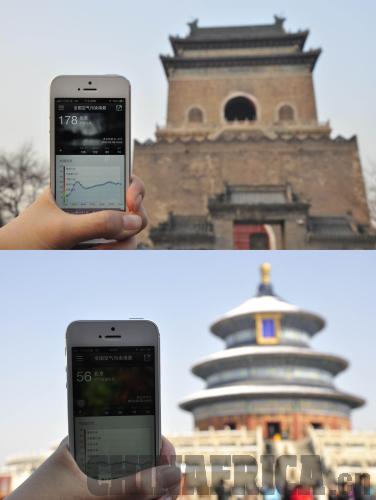China's State Council released its ActionPlan for Air Pollution Prevention and Control (Action Plan) on September 12, 2013, eight months after the widely-reported air pollution episode that occurred in January, which covered one sixth ofChina's territory.
In June, 10 measures were disclosed in a strongly-worded statement by the State Council to prevent and control air pollution, called the National 10 Measures. The Action Plan is the detailed implementation plan of the National 10 Measures with 35 sub-sections grouped under 10 measure areas.
Recently,Chai Fahe, Vice President of ChinaResearch Academy of Environmental Sciences explained and interpreted the measures of the Action Plan in detail.
|

|
|
To measure and control air pollution, the State Council's Action Plan focuses on National 10 Measures |
The Action Plan sets the road map for air pollution and control for the next five years inChinawith a focus on three key regions – Beijing-Tianjin-Hebei area, Yangtze River Delta (YRD) and Pearl River Delta (PRD). For the three key regions, annual average concentration of PM2.5 should be reduced by 25 percent, 20 percent, and 15 percent respectively by 2017, according to the Action Plan. Why are the targets different?
According to our research, the lower the concentration of PM2.5 (fine particulate matter smaller than 2.5 microns in diameter), the harder it is to control. Currently, the annual average concentration of PM2.5 in Beijing is at about 90 ug/m3level, while it's at about 50 ug/m3level in Shanghai, and the figure in cities of the Pearl River Delta region is at about 45-50 ug/m3level. We need to consider two things:
First, for cities in north China, PM2.5 mainly comes from coal consumption of heating in winter. So if we replace coal with natural gas, the concentration of PM2.5 will be greatly reduced in the north. The concentration of PM2.5 in south China could not be reduced this way, as heating is not used there.
Second, we set the targets based on the different concentration of PM2.5 and pollution levels in different regions. But one thing is clear: all regions have to make great efforts to achieve those targets. ForBeijing, it's required that the annual average concentration of PM2.5 should be reduced by 33 percent, from 90 ug/m3level to 60 ug/m3in 2017. It's a difficult task, but as long as our measures are in place, the target for Beijing-Tianjin-Hebei area can be achieved.
It seems that air pollution is getting worse in recent years. What's the biggest challenge in air pollution control and treatment in China?
Currently, we are facing the particular air pollution problem represented by PM2.5 and ozone pollution. On one hand, over the years, the high GDP growth and the extensive economic development mode have led to the increasing consumption of resources and energy. If we don't change the current development mode, upgrade and optimize the industrial structure, air pollution will continue.
On the other hand, we have made big progress in reducing emissions. For instance, we have reduced sulfur dioxide emissions by 14.3 percent during the 11th Five-Year Plan (2006-11) period. But the sources of PM2.5 are complicated, and many factors contribute to PM2.5 pollution. Pollution such as dust, sulfur dioxide, nitrogen oxides and volatile organic compounds are a byproduct of industrial production and lead to more pollutants through chemical reactions, such as PM2.5. Although we have made efforts to reduce the emissions of sulfur dioxide and nitrogen oxides, we didn't control and treat the volatile organic compounds, as well as the increasing construction site dust. Thus, those pollutants keep growing fast, and lead to PM2.5 pollution.
In your opinion, what are the highlights of the Action Plan?
The first highlight is that we put our focus on the improvement of environmental quality instead of focusing on reducing the emissions of sulfur dioxide and nitrogen oxides. I think this is a strategic change of our efforts in air pollution control and treatment.
Second, the National 10 Measures are not limited in the area of environmental protection, but are closely related with the economic and social development of the country. The Action Plan pushes us to change our economic development mode, and to make our industrial structure more energy-efficient. Those measures are not specialized proposals, but national comprehensive air pollution control and treatment programs.
Third, the Action Plan emphasizes solving air pollution problems using market mechanisms and involves nearly 20 relevant environmental policies and regulations. For instance, those who pollute will be responsible for the control and treatment of pollution; those who reduce the emissions will be rewarded, while those who don't reduce emissions will be punished. This time we use a comprehensive approach including the legal, market mechanism and administrative means to control and treat air pollution.
Fourth, this time we especially highlight the coordinated control of multiple pollutants, rather than reducing the emission of one or two kinds of pollutants.
Fifth, the plan stresses conducting both long-term environmental protection and the control and treatment of short-circle heavy pollution, including reducing the occurrence frequency, the degree of contamination and the pollution duration.
Sixth, this Action Plan emphasizes the implementation of the measures. For example, detailed targets for Beijing-Tianjin-Hebei area including the tons of coal to be reduced are set. All the figures are specific and measures are quantitative. Some regions have established effective and strict assessment mechanisms to ensure the implementation of the Action Plan. The government agencies, supervision departments and environmental protection organizations are encouraged to work together to carry out those measures.